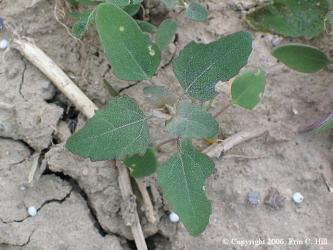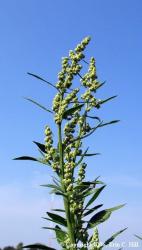Common Lambsquarters
Common Lambsquarters (Chenopodium album L.)

Life cycle:
Summer annual. Emerges in the spring sets seed in late summer/fall and dies.
Emergence:
Common lambsquarters is and early emerger. Ten percent emergence is seen by 150 GDD (base 48 deg. F); 25% emergence by 262 GDD (base 50).
C. lambsquarters emergence from soil depths of less than 1 inch.
Seed:
Production Range: 30,000 to 176,000 seeds/plant
Production Average: 72,500 seeds/plant
Dispersal Mechanisms: none
Longevity: 12 years (50% of seeds depleted), 78 years (99% depleted) One study found 32% viability after 20 years.
Dormancy: As burial depth increases, seed dormancy increases. Conditions to break dormancy include high levels of soil nitrate, exposure to light and fluctuating temperatures. Seeds on a single plant have different dormancy requirements. This is one reason why lambsquarters seeds is so persistent in the soil.

Competitiveness:
Common lambsquarters is one of the more competitive weeds. Thirteen percent yield loss in corn with one lambquarters plant per 1.5 foot of row; 25% yield loss in soybeans with less than one plant per foot of row; 48% yield loss in sugar beet from one plant per foot of row.
Preferred Soil / Field Conditions:
Rich soil, fertile in N, P, and K. Prefers soils with high levels of soil nitrate. Like high levels of calcium and magnesium. Grows well on compacted soils.
Management:
Biological
Field mice, sowbugs, millipedes, crickets, slugs, and carabid beetles all feed on common lambsquarters seeds lying on the soil surface.
About 20% of lambsquarters seed decayed in the first winter when buried 1 to 4 inches below the soil surface. Soil moisture ans soil microorganisms are needed to decay weed seeds.
Mechanical
Tillage: Tilling at night (dark tillage) will reduce lambsquarters emergence by 30 to 70%.
Rotary hoeing: When common lambsquarters is less than 1/4" tall it is easily controlled with a rotary hoe.
Flaming: At heights of 1/2" or less, flaming is an effective way to control common lambsquarters.
Cultural
Crop rotation: Adding small grains to the rotations helps suppress common lambsquarters.
Planting date: Tilling in the spring and planting later (mid-May) will reduce lambsquarters infestations because many of the plants will have emerged and been controlled by tillage.
Chemical
Lambsquarters is one of the more difficult weeds to control with postemergence herbicides in soybeans and sugar beets. Because lambsquarters emerges early, it is one of the weeds that must be watched so is does not exceed the maximum height for postemergence weed control. Furthermore, lambsquarters is one of the first weeds to become difficult to control under dry conditions. See the MSU Weed Control Guide for Field Crops for herbicide recommendations.



 Print
Print Email
Email